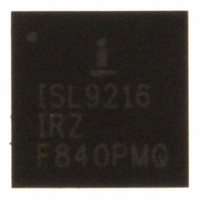ISL9216IRZ Intersil, ISL9216IRZ Datasheet - Page 23

ISL9216IRZ
Manufacturer Part Number
ISL9216IRZ
Description
IC MULTI-CELL LI-ION PROT 32-QFN
Manufacturer
Intersil
Datasheet
1.ISL9216IRZ.pdf
(33 pages)
Specifications of ISL9216IRZ
Function
Battery Monitor
Battery Type
Lithium-Ion (Li-Ion)
Voltage - Supply
9.2 V ~ 31 V
Operating Temperature
-40°C ~ 85°C
Mounting Type
Surface Mount
Package / Case
32-VQFN Exposed Pad, 32-HVQFN, 32-SQFN, 32-DHVQFN
Lead Free Status / RoHS Status
Lead free / RoHS Compliant
Available stocks
Company
Part Number
Manufacturer
Quantity
Price
Company:
Part Number:
ISL9216IRZ
Manufacturer:
BROADCOM
Quantity:
1 000
Company:
Part Number:
ISL9216IRZ
Manufacturer:
Intersil
Quantity:
802
Part Number:
ISL9216IRZ
Manufacturer:
INTERSIL
Quantity:
20 000
The load monitor circuit can be turned on or off by the
microcontroller. It is normally turned off to minimize current
consumption. It must be activated by the external
microcontroller for it to operate. The circuit works by
internally connecting the VMON pin to VSS through a
resistor. The circuit operates as shown in Figure 4.
In a typical pack operation, when an overcurrent or short
circuit event happens, the DFET turns off, opening the
battery circuit to the load. At this time, the R
the load monitor is initially off. In this condition, the voltage at
VMON could rise to nearly the pack voltage. However, since
in most configurations, this voltage would exceed the
maximum limits on the VMON pin, a series zener diode is
required.
Once the power FETs turn off, the microcontroller activates
the load monitor by setting the LDMONEN bit. This turns on
an internal FET that adds a pull-down resistor to the load
monitor circuit. While still in the overload condition the
combination of the load resistor, an external adjustment
resistor (R
resistor form a voltage divider. R
load is released to a sufficient level, the LDFAIL condition is
reset.
OVER-TEMPERATURE SAFETY FUNCTIONS
External Temperature Control
The external temperature is monitored by using a voltage
divider consisting of a fixed resistor and a thermistor. This
divider is powered by the ISL9216 TEMP3V output. This
output is normally controlled so it is on for only short periods
to minimize current consumption.
Without microcontroller intervention, the ISL9216
continuously turns on TEMP3V output (and the external
temperature monitor) for 5ms every 640ms. In this way, the
external temperature is monitored even if the microcontroller
is asleep. If the ATMPOFF bit is set, this automatic
temperature scan is turned off.
When the TEMP3V output turns on, the ISL9216 waits 1ms
for the temperature reading to stabilize, then compares the
external temperature voltage with an internal voltage divider
that is set to TEMP3V/13. When the thermistor voltage is
below the reference threshold after the delay, an external
temperature fail condition exists. To set the external over-
temperature limit, set the value of R
the resistance of the thermistor at the over-temperature
threshold.
The TEMP3V output pin also turns on when the
microcontroller sets the AO3:AO0 bits to select that the
external temperature voltage. This causes the TEMPI voltage
to be placed on AO and activates (after 1ms) the over-
temperature detection. As long as the AO3:AO0 bits point to
the external temperature, the TEMP3V output remains on.
1
), the zener diode, and the internal load monitor
23
1
is chosen so that when the
X
resistor to the 12 times
L
is small and
ISL9216, ISL9217
Because of the manual scan of the temperature, it may be
desired to turn off the automatic scan, although they can be
used at the same time without interference. To turn off the
automatic scan, set the ATMPOFF bit.
The microcontroller can over-ride both the automatic
temperature scan and the microcontroller controlled
temperature scan by setting the TEMP3ON configuration bit.
This turns on the TEMP3V output to keep the temperature
control voltage on all the time, for a continuous monitoring of
an over-temperature condition. This likely will consume a
significant amount of current, so this feature is usually used
for special or test purposes.
Protection
As a default, when the ISL9216 detects an internal or
external over-temperature condition, the FETs are turned off,
the cell balancing function is disabled, and the IOT bit or
XOT bit (respectively) is set.
Turning off the FETs in the event of an over-temperature
condition prevents continued discharge or charge of the cells
when they are over heated. Turning off the cell balancing in
the event of an over-temperature condition prevents damage
to the IC in the event too many cells are being balanced,
causing too much power dissipation in the ISL9216.
I
AO
2
C
FIGURE 5. EXTERNAL TEMPERATURE MONITORING AND
TEMP FAIL
INDICATOR
XOT
DECODE
MUX
I
2
C
CONTROL (ISL9216 ONLY)
ISL9216
EXT TEMP
AO3:AO0
ATMPOFF
TMP3ON
OSC
VSS (ON)
DELAY
EXTERNAL
MONITOR
1ms
TEMP
5ms
635ms
TEMPI
VSS
RGO
TEMP3V
November 2, 2007
R
FN6488.1
X
TO
µC













